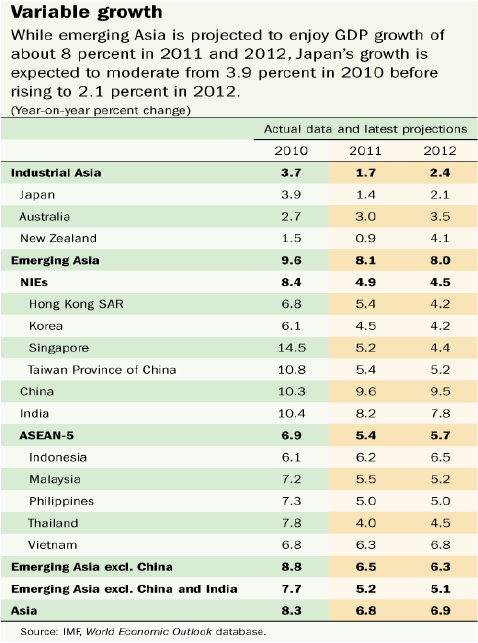REGIONAL ECONOMIC OUTLOOK:
Asia: Robust Growth,
But Inflation Causing Concern
IMF Survey online
April 28, 2011
After reaching a rate of 8.3 percent in 2010, GDP growth in Asia is projected to average nearly 7 percent in both 2011 and 2012, according to the IMF.
Although the earthquake in Japan in mid-March caused terrible loss of life and property, the government’s response helped to contain the economic impact, and spillovers to the rest of Asia through the supply chain should be limited.
But in its regular report on the economic outlook of the Asia and Pacific region, the IMF warns that Asia’s rapid recovery from the global economic crisis has been accompanied by pockets of overheating across the region.
The threat of overheating
At the launch of the IMF’s twice-yearly Regional Economic Outlook held in Hong Kong, Anoop Singh, head of the Fund’s Asia and Pacific department, said economic growth in Asia was expected to remain robust, fueled by both exports and domestic demand, but new risks had emerged, including the threat of inflation.
“Headline CPI inflation has accelerated since October 2010, and while this initially reflected higher commodity prices, pressures have now spilled over into core inflation and inflation expectations,” said Singh.
“While we expect inflation in many Asian economies to increase further in 2011 before decelerating modestly in 2012, inflation risks in Asia remain tilted on the upside.”
The IMF economist also noted that credit growth was not far from the “boom” levels in a number of economies, while property prices continued to grow rapidly in a few regional markets.
As well as the danger posed by exuberant credit and property markets, Singh also identified additional risks from higher commodity prices, volatile capital inflows and possible spillovers from Japan’s earthquake.

Tightening macroeconomic policies
Against this background, Singh said the need to tighten macroeconomic policies in Asia had become more pressing than it was six months ago.
“Further monetary tightening is necessary in economies that are facing generalized inflation pressures, as interest rates are generally negative,” said Singh.
He added that there was also room for further fiscal consolidation and exchange rates appreciation that would help contain inflationary pressures.
While the task of monetary tightening has been complicated by surges of capital flows to Asia after the global crisis, their recent moderation gives central banks more room to raise rates. Capital is expected to continue flowing into Asia in 2011 and 2012, attracted by the region’s strong growth prospects and fueled by abundant global liquidity and risk appetite, but at a more moderate pace than in 2009 and early 2010.
Capital inflows remain a concern
Still, increased volatility of capital inflows, especially debt related inflows, “remains a key concern,” for a few regional economies where these flows have been particularly large, says the Regional Economic Outlook.
The report notes that several Asian economies have introduced macroprudential measures aimed at reducing the risk of overheating in asset markets, and staving off any subsequent bust if capital flows reverse. These measures include reducing banks and household leverage, and cooling down property markets.
“These measures have been helpful,” says the report, but stresses they are “complements” and not a substitute for macroeconomic policy.
Balanced, sustainable, inclusive growth
Over the longer term, the report says the main challenge for Asia’s policymakers is to achieve a balanced, sustainable, and more inclusive pattern of growth and it warns that the global imbalances that characterized the pre-crisis period remain unchanged.
“Without policies targeted at correcting these underlying distortions, they could threaten global growth prospects,” it warns.
Among the challenges it identifies are strengthening domestic demand in Asian emerging economies, allowing the exchange rate to appreciate in some economies, narrowing inequality through inclusive labor markets, and offering stronger social protection.
Không có nhận xét nào:
Đăng nhận xét